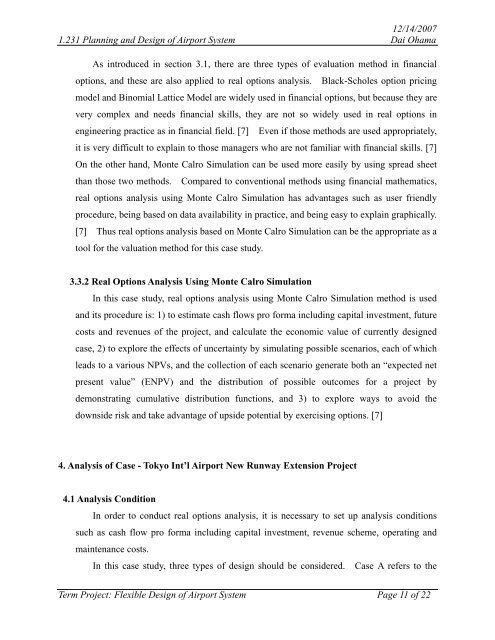Flexible Design of Airport System Using Real Options Analysis - MIT
Flexible Design of Airport System Using Real Options Analysis - MIT
Flexible Design of Airport System Using Real Options Analysis - MIT
You also want an ePaper? Increase the reach of your titles
YUMPU automatically turns print PDFs into web optimized ePapers that Google loves.
12/14/2007<br />
1.231 Planning and <strong>Design</strong> <strong>of</strong> <strong>Airport</strong> <strong>System</strong> Dai Ohama<br />
As introduced in section 3.1, there are three types <strong>of</strong> evaluation method in financial<br />
options, and these are also applied to real options analysis. Black-Scholes option pricing<br />
model and Binomial Lattice Model are widely used in financial options, but because they are<br />
very complex and needs financial skills, they are not so widely used in real options in<br />
engineering practice as in financial field. [7] Even if those methods are used appropriately,<br />
it is very difficult to explain to those managers who are not familiar with financial skills. [7]<br />
On the other hand, Monte Calro Simulation can be used more easily by using spread sheet<br />
than those two methods. Compared to conventional methods using financial mathematics,<br />
real options analysis using Monte Calro Simulation has advantages such as user friendly<br />
procedure, being based on data availability in practice, and being easy to explain graphically.<br />
[7] Thus real options analysis based on Monte Calro Simulation can be the appropriate as a<br />
tool for the valuation method for this case study.<br />
3.3.2 <strong>Real</strong> <strong>Options</strong> <strong>Analysis</strong> <strong>Using</strong> Monte Calro Simulation<br />
In this case study, real options analysis using Monte Calro Simulation method is used<br />
and its procedure is: 1) to estimate cash flows pro forma including capital investment, future<br />
costs and revenues <strong>of</strong> the project, and calculate the economic value <strong>of</strong> currently designed<br />
case, 2) to explore the effects <strong>of</strong> uncertainty by simulating possible scenarios, each <strong>of</strong> which<br />
leads to a various NPVs, and the collection <strong>of</strong> each scenario generate both an “expected net<br />
present value” (ENPV) and the distribution <strong>of</strong> possible outcomes for a project by<br />
demonstrating cumulative distribution functions, and 3) to explore ways to avoid the<br />
downside risk and take advantage <strong>of</strong> upside potential by exercising options. [7]<br />
4. <strong>Analysis</strong> <strong>of</strong> Case - Tokyo Int’l <strong>Airport</strong> New Runway Extension Project<br />
4.1 <strong>Analysis</strong> Condition<br />
In order to conduct real options analysis, it is necessary to set up analysis conditions<br />
such as cash flow pro forma including capital investment, revenue scheme, operating and<br />
maintenance costs.<br />
In this case study, three types <strong>of</strong> design should be considered. Case A refers to the<br />
Term Project: <strong>Flexible</strong> <strong>Design</strong> <strong>of</strong> <strong>Airport</strong> <strong>System</strong> Page 11 <strong>of</strong> 22

















